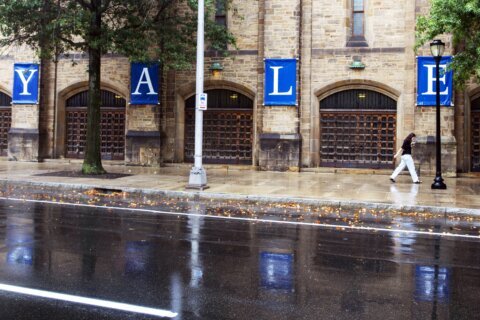Many parents likely dream of a guilt-free summer — a break from the pressure of online learning for their kids, a hiatus from helping with homework and some time off from balancing it all. But what about summer reading and the threat of a “slide” after many students struggled to stay on top of academics during the coronavirus pandemic?
A mindset shift is in order because “summer reading is a celebration,” says Cathy Bogart, a second grade teacher at Normandy Elementary School in Bay Village, Ohio. Bogart hopes parents approach summer reading as an adventure with no strings attached.
“Parents today have such feelings of guilt over so much, and it’s unnecessary. Summer reading can be an adventure,” Bogart says, reframing what might seem a chore to some children as a chance to show off their skills. “It’s a time to enjoy, and practice and apply what they learned. During the school year, it’s always, ‘We have to learn more,’ and summer is a time to enjoy what they learned.”
Summer reading unlocks opportunities to explore subjects a child is interested in, and it’s an early start to lifelong learning, says Kymberlee Powe, children and young adult consultant at the Connecticut State Library. “If we get our children into the habit of reading and wondering and researching and doing, we are building that connective learning and lifelong learning strategy into everything they do, which carries into adulthood,” she says.
Children can find “their thing” in a book. “That ability to pick a topic and explore it is a pathway to further success,” says Luke Kralik, organizational coordinator for the Collaborative Summer Library Program, which develops and implements summer reading programs used nationwide. “A lot of times, children who are super interested in horses or cars — those might become a lifelong passion for them.”
[READ: Virtual Field Trips for Kids: Worldwide Wonders.]
And reading is a way for children to understand how others feel. “It’s one way people develop empathy skills by reading about others’ perspectives and learning about the headspace other folks are living in,” Kralik says. “Children can’t peer into each other’s heads, but reading can be a menu for learning about the world and about other people.”
As for how much time per day a child should read, experts say there’s no magic number. “You often hear 20 minutes a day in schools and libraries, but we want to encourage children to read a little bit every day so it becomes a habit,” Powe says. “Then, reading becomes a choice and it’s no longer a chore.”
Kralik agrees, noting that consistency is the key. “It’s more about creating a routine and making sure those reading skills stay fresh,” he says. “It depends on the child. If reading isn’t fun and you’re sitting in the corner with a book for a half hour, you’re probably not gaining those benefits as opposed to building reading into a routine based on the child.”
How to Encourage Summer Reading
As families embark on a summer reading celebration, here are some ways for parents to encourage young readers and enjoy the experience.
Make the experience easy and interesting. Some children struggle to read silently to themselves because they need to sound out words. Others are more easily engaged if they can read to an audience, whether a sibling, parent or stuffed animal, Bogart says. Even choosing a special spot like a favorite chair, or taking reading outdoors on a beach blanket or under a shade tree, can inspire a sense of adventure.
“Summer reading is a time to enjoy what they learned and it should be about topics they love and are interested in,” says Bogart, emphasizing the importance of “ease of text, interest of text and where they are reading.”
Use audiobooks. “Reading can look like a lot of things, and one thing that shocks parents is reading can be audiobooks,” Powe says. “Even though they’re not reading a book, their brain is still working. They are still learning and anticipating what will happen next. So, reading can look like listening.”
[READ: Podcasts for Kids.]
Powe suggests that parents play an audiobook while preparing dinner with their child, or use time in the car as an opportunity to listen to a story together. Also, audiobooks that accompany a written version allow children to hear the words on the page, which can be helpful for kids who struggle with reading and students who speak English as a second language.
Make every word count. From recipes and cereal boxes to magazines and street signs, reading doesn’t have to mean quiet time with a book. Graphic novels are a gateway for many young readers, Bogart adds.
“There are a variety of texts, not just narratives, but how-tos such as, ‘How to Make an Ice Cream Cone,’ with the steps listed. And, poetry is an amazing way for children to practice critical thinking.” Parents can take turns reading lines of a poem with their child, she suggests. “It increases fluency.”
Return to the library. After months of perhaps staying out of a public library and checking out books that others also borrow, it’s time to return to a place that can practically fulfill all five senses, Bogart says. Trading devices like Chromebooks and iPads for books with pages is a welcome “summer vacation” from a year of online learning.
“They can see the books and people reading, they can hear a calming quiet silence, if you will, and they can touch books — even the smell,” she says. “They can hear the crinkle of a book that is being opened. All of these opportunities are concrete and part of the development process of reading, and it’s all there at the library.”
Show, don’t tell. Parents who read send a strong and silent message that books matter. Set an example by picking up a book to take a break, unwind, find answers or learn about something new.
“Those modeling behaviors are huge,” Kralik says, suggesting that parents try reading the same book as their child but stop halfway through. “It’s up to the child to fill you in on what happens in the rest of the book. This makes reading participatory and you can build a stronger relationship with your child through shared reading.”
Read and re-read. Powe says parents shouldn’t worry if their child wants to read the same book over and over again. “Let them keep reading it,” she says. “They are still reading, and they might be picking up on new things every time — something they missed out on. When we let the kids read what they want, reading becomes a choice and not a chore. One day they will migrate to something else.”
Summer Reading Book Suggestions
Below is a diverse list of summer reading books curated based on experts’ suggestions. These recommendations include a range of titles, from famous series like Elephant & Piggie and Magic Tree House to books that just hit the shelves and Caldecott Medal winners. A selection of fiction, nonfiction, biographies and graphic novels gives students at reading levels from beginner to middle school choices that will appeal to their interests.
Early Readers (Pre-K and Kindergarten)
— Elephant & Piggie series by Mo Willems
— Fly Guy Presents series by Tedd Arnold
— Everyone’s Awake by Colin Meloy
— Sandcastle by Einat Tsarfati
— Common Critters: The Wildlife in Your Neighborhood by Pat Brisson
— Double Trouble by Sarah Dyer
1st to 3rd Grade Readers
— Allergic: A Graphic Novel by Megan Wagner Lloyd
— Owl Diaries by Rebecca Elliott
— Magic Tree House series by Mary Pope Osborne
— Junie B. Jones series by Barbara Park
— Zoey and Sassafras series by Asia Citro
— Ralph S. Mouse by Beverly Cleary
— Wonder by R.J. Palacio
— The World According to Humphrey by Betty G. Birney
— InvestiGators by John Patrick Green
4th to 5th Grade Readers
— Prairie Lotus by Linda Sue Park
— New Kid by Jerry Craft
— We Are Water Protectors by Carole Lindstrom
— A Wish in the Dark by Christina Soontornvat
— The Midnight Hour by Benjamin Read and Laura Trinder
— The One and Only Bob by Katherine Applegate
— Wink by Rob Harrell
— The Undefeated by Kwame Alexander
— The Next President: The Unexpected Beginnings and Unwritten Future of America’s Presidents by Kate Messner and Adam Rex
Middle School Readers (6th to 8th Grades)
— Tristan Strong Punches a Hole in the Sky by Kwame Mbalia
— Blended by Sharon M. Draper
— Firegirl by Tony Abbott
— Restart by Gordon Korman
— The Brooklyn Nine by Alan Gratz
— Echo by Pam Muñoz Ryan
— One Crazy Summer by Rita Williams-Garcia
— Wish by Barbara O’Connor
— Island of the Blue Dolphins by Scott O’Dell
— Dear Mr. Henshaw by Beverly Cleary
Searching for a school? Explore our K-12 directory.
More from U.S. News
Ways to Keep Kids on Track With Reading During the Pandemic
How to Celebrate Your Child’s 8th Grade Graduation
How to Find the Best Coding Programs for Kids
Summer Reading: Book Ideas for Parents of K-8 Students originally appeared on usnews.com







